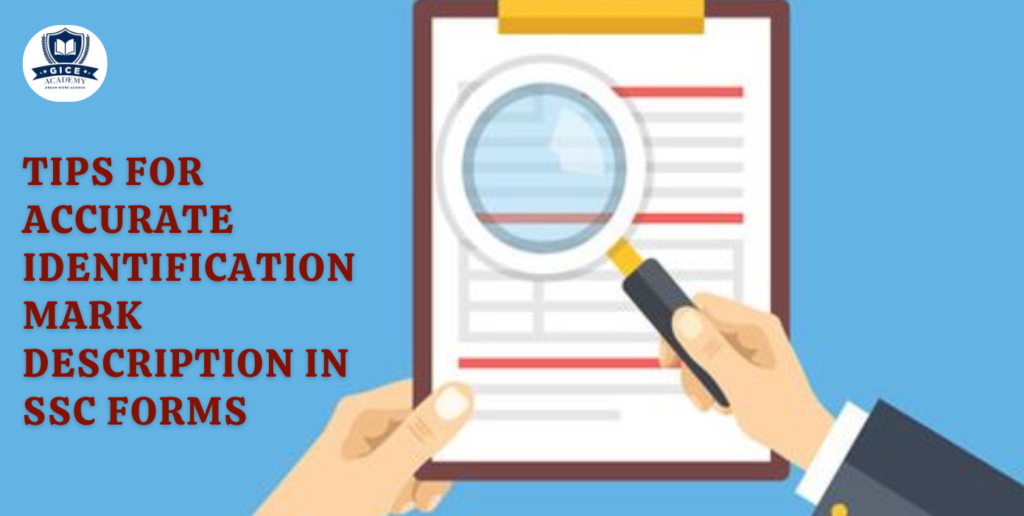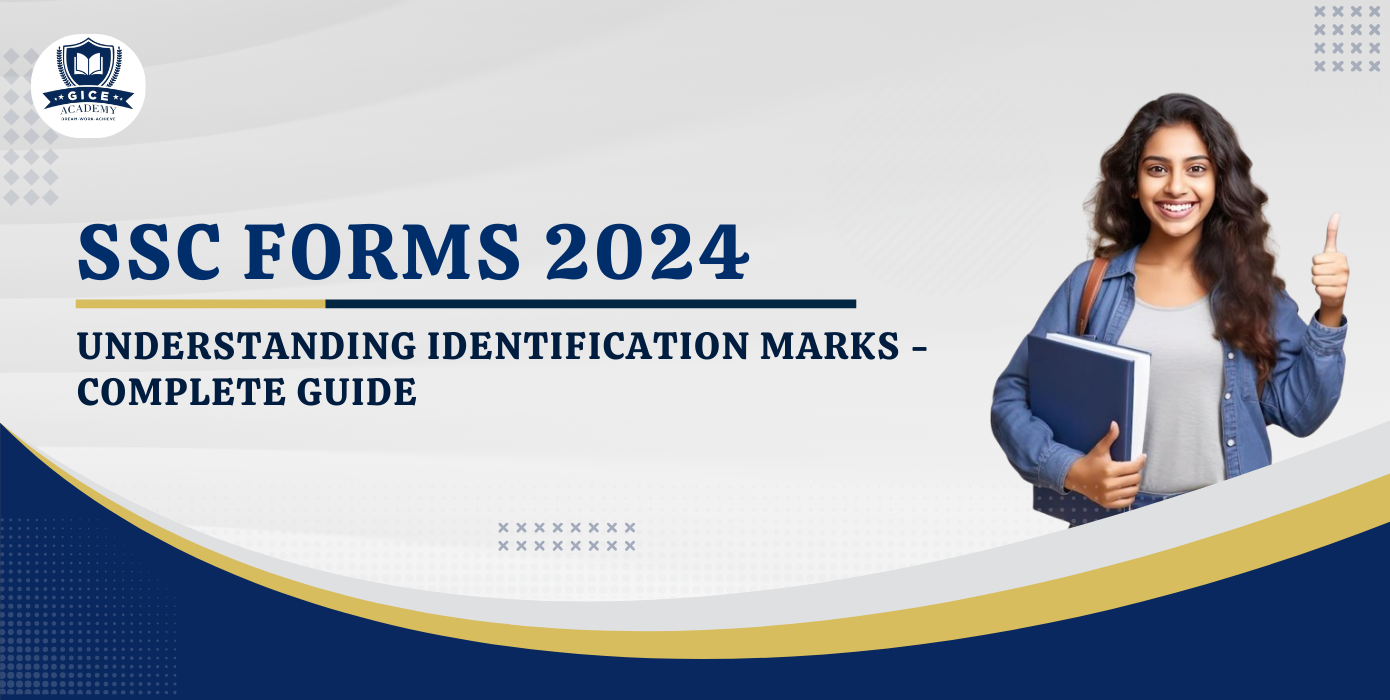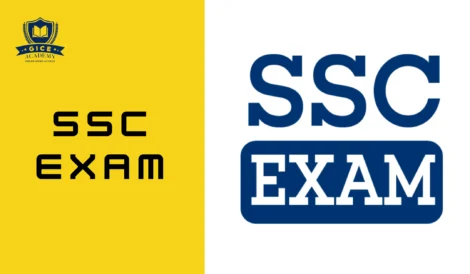Table of Contents
Introduction
When you fill out forms for the Staff Selection Commission (SSC), one part that can confuse you is the identification mark. This is a unique physical feature that helps identify you. It’s really important for SSC because it ensures they can recognize each candidate clearly during exams and other official processes. In this blog, by GICE Academy, we’ll explain what identification marks are, why they’re needed, how to choose one, and more.
Identification marks are things like scars, birthmarks, tattoos, or specific moles that make you different from others. They help SSC avoid mix-ups and confirm your identity during exams. It’s crucial to describe your mark accurately in the SSC forms so they can identify you correctly.
Keep reading to understand why identification marks matter in SSC forms and get tips on filling out this important section.
What is an identification mark?
Identification Marks are unique physical characteristics that distinguish an individual from others. These marks are typically permanent and easily visible. They are used in various forms and documents to verify identity, especially in competitive exams like SSC.
Examples of identification marks:
- Moles: small, often dark spots on the skin.
- Scars are permanent marks left on the skin after injury or surgery.
- Birthmarks: congenital, visible marks on the skin.
- Tattoos are permanent designs on the skin.
Why is it required in SSC forms?
The requirement of an identification mark on SSC forms serves several purposes:
- Verification: It helps verify the candidate’s identity during exams, interviews, and document verification processes.
- Security: Ensures that the right person is appearing for the examination, minimizing the chances of impersonation.
- Record-keeping: maintains a detailed record of the candidates, which is crucial for administrative purposes.
How do I choose an identification mark in SSC forms?
When choosing an identification mark for your SSC form, consider the following:
- Visibility: Choose a mark that is easily visible and identifiable.
- Permanence: Ensure that the mark is permanent and not subject to change over time.
- Uniqueness: The mark should be unique to you and not a common feature among many people.
Tips for Choosing an Identification Mark in SSC forms:
- Select a mole or scar that is visible.
- Avoid temporary marks like henna tattoos.
- Ensure that the mark is in a place that can be easily shown if required, such as on your hand, face, or neck.
Common Identification Marks Examples in SSC forms
- Moles
Moles are one of the most common identification marks. They vary in size and location. A facial, arm, or neck mole can be a distinctive feature.
- Scars
Scars from injuries or surgeries are also used as identification marks. They are unique due to their shape and location. For instance, a scar on the forehead or hand is easily recognizable.
- Birthmarks
Birthmarks are congenital and serve as excellent identification marks. They can be of various shapes, sizes, and colors, making them unique to an individual.
- Tattoos
If you have a tattoo, it can serve as an identification mark, provided it is in a visible area. Tattoos are permanent and unique, making them ideal for this purpose.
Step-by-Step Guide to Filling the Identification Mark in SSC Forms
Filling out the identification mark section in SSC forms is straightforward if you follow these steps:
Step 1: Identify Your Mark
Look for a visible, permanent, and unique mark on your body. This could be a mole, scar, birthmark, or tattoo.
Step 2: Describe the Mark
In the SSC forms, you will need to provide a brief description of the mark. Be specific about the location and characteristics of the mark. For example:
Mole on the left cheek, scar on the right forearmBirthmark on the left shoulder; tattoo on the right wrist
Step 3: Fill in the Form
Enter the description of your identification mark in the designated section of the SSC forms. Make sure the information is clear and accurate.
Step 4: Double-Check the Details
Before submitting the form, review the details to ensure there are no errors. The identification mark should be clearly described to avoid any confusion during the verification process.
Importance of Accurate Identification Marks in SSC forms
Providing an accurate identification mark is crucial for several reasons:
- Avoiding Discrepancies: Accurate details prevent any discrepancies during the verification process.
- Ensuring Authenticity: Correct information helps in establishing the authenticity of the candidate.
- Facilitating Smooth Verification: Accurate identification marks ensure a smooth verification process, saving time and effort.
Consequences of Incorrect Identification Marks in SSC forms
- Rejection of Application: Incorrect details can lead to the rejection of your application.
- Verification Issues: Incorrect marks can cause problems during the verification process, leading to delays or disqualification.
- Legal Consequences: In some cases, providing false information can have legal implications.
Mistakes to Avoid When Filling Identification Marks in SSC forms

Common Mistakes
- Using Temporary Marks: Avoid using temporary marks like henna or temporary tattoos.
- Inaccurate Descriptions: Ensure the description of the mark is precise and clear.
- Overlooking the Field: Do not leave the identification mark field blank. If you don’t have any, mention “None.”
- Using Common Features: Avoid mentioning common features like “freckles,” which are not unique identifiers.
Tips to Avoid Mistakes in SSC forms
- Double-check the details before submission.
- Consult with someone if you are unsure about your identification mark.
- Keep a copy of your filled-out form for future reference.
Legal Implications of Providing Incorrect Identification Marks in SSC forms
Providing false or misleading information about your identification mark can have serious legal consequences. The SSC has stringent rules to ensure the authenticity and integrity of the examination process. Here are some potential legal implications:
Disqualification from the Examination
If found providing false information, candidates may face immediate disqualification from the examination process. This can have long-term implications for your career and future applications.
Legal Action
In severe cases, providing false information can lead to legal action. The SSC can take stringent measures to maintain the integrity of the examination process, including filing cases against candidates who attempt to deceive.
Permanent Ban
Candidates who provide false information may also face a permanent ban from appearing in any future SSC examinations. This would significantly impact your ability to pursue a career in government services.
Tips for Accurate Identification Mark Description in SSC forms

Be Specific
When describing your identification mark, be specific about its location and characteristics. For example, “small mole on the left cheek” is better than just “mole.”
Use Common Terms
Use terms that are commonly understood. Avoid using medical jargon or overly technical descriptions.
Check Visibility
Ensure that the identification mark you choose is easily visible and can be shown during the verification process if needed.
Update if Necessary
If your identification mark changes due to an injury or other reasons, update the SSC authorities promptly.
Common Queries About Identification Marks in SSC forms
Can a Birthmark Be Used as an Identification Mark?
Yes, birthmarks are ideal identification marks as they are unique and permanent. They can vary in shape, size, and color, making them distinctive.
What If I Don’t Have an Identification Mark?
If you don’t have any visible identification marks, you can mention “None” in the identification mark section of the form. It’s better to be honest than to invent a mark.
Are Tattoos Accepted as Identification Marks?
Yes, tattoos are accepted as identification marks, provided they are permanent and in a visible area. Make sure to describe the tattoo accurately, including its location.
How do you describe multiple marks?
If you have more than one identification mark, you can list them all in the form. For example, “move on the right hand and scar on the left forearm.”
Can Freckles Be Used as Identification Marks?
Freckles are usually not recommended as identification marks because they can change over time and are not unique to an individual.
Additional Information: SSC GD, SSC CPO, and SSC CHSL
SSC GD (General Duty) and SSC CPO (Central Police Organization) are popular exams conducted by the Staff Selection Commission. Both of these exams require candidates to fill out the identification mark section accurately to ensure smooth verification during the recruitment process.
SSC GD
The eligibility criteria for SSC GD include age limits, educational qualifications, and physical standards. Filling out the identification mark section accurately is crucial for the document verification stage.
SSC CPO
For SSC CPO, candidates must meet specific eligibility criteria related to age, education, and physical fitness. Accurate identification marks help in verifying the identity of the candidates during physical tests and interviews.
Latest Updates
Stay updated with the latest updates on SSC exams, including changes in exam dates, eligibility criteria, and application processes. Regularly check the official SSC website for announcements.
Download SSC CHSL and Other SSC Exam Resources
Candidates can download SSC CHSL admit cards, results, and other exam-related documents from the official SSC website. It’s essential to have all the necessary documents, including a properly filled-out identification mark section, for the SSC CHSL exam.
In our upcoming blog, sponsored by GICE Academy, we will shift our focus to the Common Law Admission Test (CLAT). Stay tuned as we explore important aspects such as exam structure, preparation tips, and how to excel in this highly competitive law entrance exam. Whether you’re a first-time applicant or looking to enhance your preparation strategy, our next blog will provide valuable insights to help you succeed in CLAT.
FAQ
What if I don’t have a visible identification mark?
If you do not have a visible identification mark, you can mention “None” in the identification mark section of the form.
Can I use a temporary mark as an identification mark?
No, temporary marks like henna tattoos or temporary tattoos should not be used. Only permanent marks are acceptable.
What if my identification mark changes after submitting the form?
If your identification mark changes due to any reason (like a new scar), you should inform the SSC authorities and get the details updated in your form.
How specific should the description of the identification mark be?
The description should be precise, mentioning the type of mark and its exact location. For example, “Small mole on the right cheek” is a clear description.
Is it mandatory to fill in the identification mark in the SSC forms?
Yes, it is a mandatory field and must be filled accurately.





